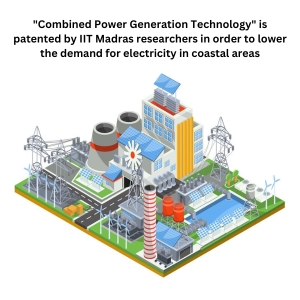"Combined Power Generation Technology" is patented by IIT Madras researchers to lower the demand for electricityPosted by Atul on October 26th, 2023  Introduction to Combined Power Generation TechnologyWe will be discussing the introduction of a revolutionary power generation technology developed by researchers at the Indian Institute of Technology (IIT) Madras. The patented Combined Power Generation Technology aims to reduce electricity demand in coastal areas, while also addressing issues such as carbon footprint and reliance on traditional power sources. Let's delve deeper into how this technology works and its potential impact. Developed by researchers at IIT Madras, this technology combines multiple methods of power generation to optimize energy production. These methods include solar, wind, tidal, and wave energy. By utilizing these renewable sources, the technology aims to reduce the dependence on nonrenewable sources of energy such as coal and oil. One of the key benefits of this technology is its potential for coastal areas with limited access to reliable electricity. Many remote coastal regions face challenges in accessing electricity from traditional power grids due to their location. This can have a significant impact on these communitie's development and quality of life. In addition to providing reliable electricity access to coastal communities, this patented technology also has the potential to lower the cost of electricity in these areas. Traditional power sources require maintenance and regular fuel supply, which can add up to significant operational costs. Understanding Coastal Areas and their Electricity DemandsTo address this issue, researchers at IIT Madras have come up with a solution – Combined Power Generation Technology (CPGT). This patented technology combines different power generation methods to reduce the electricity demand in coastal areas. Let’s take a closer look at CPGT and how it can help in understanding and meeting the electricity demands of coastal areas. Firstly, what exactly is CPGT? It is a technology that integrates multiple power generation methods, such as wind energy, solar energy, and thermal energy, into one system. This allows for a more efficient use of resources and reduces the overall demand for electricity. The concept behind CPGT is to use the strengths of each power generation method to offset any weaknesses or limitations. The researchers at IIT Madras have identified that coastal areas have unique characteristics that make them suitable for this technology. For instance, these regions often experience high wind speeds and receive ample sunlight throughout the year. Due to their proximity to large bodies of water, they also have access to thermal energy from ocean currents or temperature differences between land and sea. By harnessing these different sources of energy simultaneously through CPGT, it is possible to meet the high electricity demands of coastal areas without relying too heavily on a single source. This not only helps in reducing costs but also minimizes the impact on the environment. The Need for Sustainable Energy Solutions in Coastal AreasCoastal areas are home to a large population and also attract tourists from all around the world. With their stunning beaches, picturesque views, and diverse ecosystems, these areas not only provide economic benefits but also hold great cultural and environmental significance. Coastal areas are highly vulnerable to the impacts of climate change due to their proximity to the ocean. Rising sea levels, intense storms, and coastal erosion are just some of the challenges that these regions face. A team of researchers from the Indian Institute of Technology (IIT) Madras has recently patented a new technology called "Combined Power Generation Technology" specifically for coastal areas. This technology aims to reduce the demand for electricity in these regions by utilizing both solar and wind energy. The beauty of this technology lies in its ability to complement one another when there is ample sunlight, wind may not be as strong, and vice versa. By combining these two sources of renewable energy, there is a higher chance of consistent power generation throughout the day. Furthermore, this technology is also designed keeping in mind the unique challenges faced by coastal regions. For instance, traditional wind turbines may not be compatible with high velocity winds near coastlines. In addition to addressing energy needs in coastal areas, this technology also has other benefits. It reduces dependency on fossil fuels which contribute significantly to global warming and allows for more sustainable development in these regions. Overview of Combined Power Generation Technology (CPGT)CPGT is a patented technology developed by a team of researchers at IIT Madras, with the aim of reducing the demand for electricity in coastal areas. But what exactly is CPGT and how does it work? Let's delve into the details. In simple terms, CPGT combines two sources of energy, solar and wave to generate electricity. The idea behind this technology is to use the abundant solar energy available in coastal regions and combine it with wave energy, which is also a renewable source. This combination creates a more efficient system that can produce electricity round the clock, unlike traditional solar or wind power plants which have limitations due to weather conditions. The CPGT system consists of three main components: solar panels, wave energy converters and power generation units. The solar panels are placed on floating platforms in water bodies such as lakes or reservoirs, while wave energy converters are installed on offshore structures like breakwaters or submerged platforms. These converters harness the kinetic energy from waves and convert it into electricity through mechanical motion. One of the biggest advantages of CPGT is its scalability. This means that it can be installed in various sizes depending on the demand for electricity in a particular area. As coastal regions tend to have densely populated cities and towns, CPGT can be customized according to their needs, making it a versatile solution for meeting their energy demands. Implementation and Challenges of CPGT in Coastal AreasAre you tired of frequent power outages in your coastal area? Do you worry about the electricity demand and its impact on the environment? Well, there might be a solution to these problems: Combined Power Generation Technology (CPGT). CPGT is a patented technology developed by researchers at the Indian Institute of Technology, Madras. It aims to address the electricity demand in coastal areas, which often face challenges due to their geographical location. As the name suggests, CPGT combines different power generation sources to provide a reliable and sustainable energy solution. So, how does CPGT work? Let's find out. The technology utilizes solar energy as its primary source of power. Solar panels are installed in large areas, such as beaches or rooftops, to capture sunlight and convert it into electricity using photovoltaic cells. This solar energy is then stored in batteries for future use. But that's not all CPGT also integrates wind turbines into its system. These turbines are strategically placed along the coastline where wind speed is high. As the wind turns the blades of the turbine, it generates electricity that is sent to an electrical grid for distribution. The combination of solar and wind energy ensures a constant supply of electricity even during periods of low sunlight or calm winds. One of the biggest advantages of CPGT is its ability to provide uninterrupted power supply in remote coastal areas without relying on conventional fossil fuel based power plants. It also reduces carbon emissions and helps combat climate change. The Potential Impact of CPGT on Reducing Dependence on Conventional Sources of Energy in Coastal AreasCoastal areas are no stranger to the impacts of climate change. Rising sea levels, increased storm frequency, and loss of biodiversity are just some of the consequences that these regions face. This reliance on fossil fuels not only contributes to climate change but also poses a threat to the environment and human health. Fortunately, researchers at IIT Madras have developed a solution to this problem: Combined Power Generation Technology (CPGT). This patented technology aims to reduce coastal area's dependence on conventional energy sources by harnessing the power of wind and waves. So, what exactly is CPGT? In simple terms, it combines two renewable energy sources – wind and wave – to generate electricity. While wind energy is well known and commonly used, harnessing wave energy is still a relatively new concept. One of the key benefits of CPGT is its ability to provide a more stable and consistent source of energy compared to relying on only one source. Wind turbines often experience fluctuations in power generation due to varying wind speeds, while wave energy devices can generate electricity consistently across different weather conditions. Moreover, coastal areas are an ideal location for implementing CPGT due to their proximity to both wind and wave resources. This reduces the need for long distance transmission lines, which can be costly and cause energy losses along the way. By utilizing CPGT, coastal communities can significantly reduce their dependence on conventional sources of energy like coal or natural gas. Check Out:Like it? Share it!More by this author |


